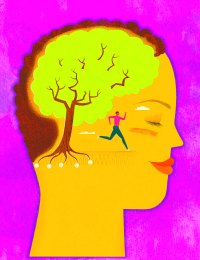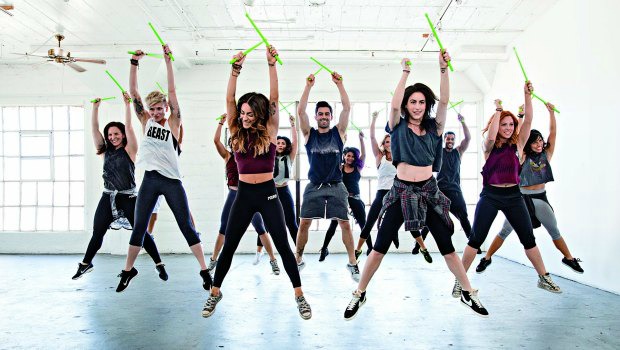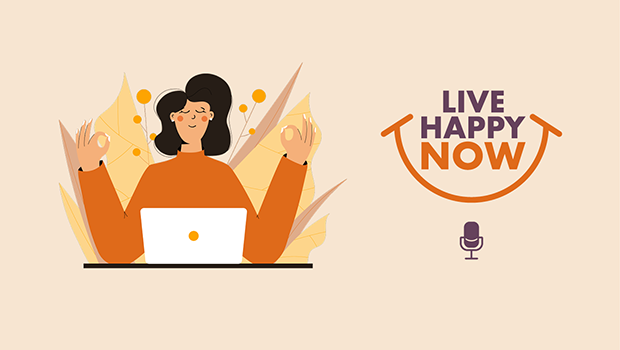New studies show the many ways exercise can boost your brain.
Holly Becka Pry remembers exactly when—and why—she realized she had to start exercising. “Our son was about 5 or 6 years old, and we had taken a family vacation to Disneyland,” says Holly, of McKinney, Texas. “I knew I had gained weight over the last few years, but it wasn’t until I saw those vacation pictures that I realized just how much I had put on.”
As a wife and working mother, Holly was accustomed to juggling many roles, but suddenly realized she had focused on work and family to her own detriment. It was completely inconsistent with who she had always planned to be.
“I wanted to set a good example for my son. I wanted to have a good, healthy body image and be at a healthy weight. And I wanted to live a long and healthy life.” Holly immediately started hitting the gym, knowing that the muscle memory from her days as a high school athlete—she played tennis and was involved in cheerleading and dance—would help her lose weight fairly quickly.
While she knew what exercise could do for her body, she didn’t anticipate what it would do for her mind. After working with a trainer for a couple of years—and losing 30 pounds along the way—she discovered Zumba and opened the door to a passion for fitness she’d never known before.
“It’s like it was made for me,” says Holly, who started practicing Zumba about five years ago and now is a certi fied instructor. She’s also received her certification as a Beachbody coach and is a certi fied Aerobic Fitness Association instructor.
“I loved everything about it—the music, the movement, the people—it all made me feel so happy. I got hooked.”
Now, when she has a stressful day at her job as a marketing communications manager for an engineering firm, or when she’s feeling a bit under the weather, Holly finds teaching or attending a fitness class can change her mood instantly. She loves the endorphin rush and the connection she feels with others in the class. Whether it’s kickboxing, Zumba or a good core strengthening class, she says it’s an automatic reset button for her.
“It’s the best stress reliever I’ve found. I can’t wait to get to the gym, and I feel like I cope better with everyday stressors. It makes me feel so happy.”
Movement and Your Mind
What Holly feels when she’s exercising is a well-documented phenomenon. Although there’s plenty of evidence that exercise gives us an emotional boost, the “why” of that response has taken longer to discover. Neuroscientists studying the role exercise plays in our mental and emotional health have found that it boosts our psychological well-being as well as our physical strength.
 “Our mind thrives on patterns, or algorithms,” explains Joseph Cardillo, Ph.D., a best-selling author and research associate at Mind-Body Institute International. “Exercise uses all the core processing components of our brain, and when you create a pattern through exercise, our minds and bodies love that.”
“Our mind thrives on patterns, or algorithms,” explains Joseph Cardillo, Ph.D., a best-selling author and research associate at Mind-Body Institute International. “Exercise uses all the core processing components of our brain, and when you create a pattern through exercise, our minds and bodies love that.”
As a result, as we use our brains differently through exercise—whether it’s creating a rhythm in your jogging pace, learning a series of dance moves or focusing on using breath to calm and sustain ourselves—those new patterns become ingrained.
“Your brain makes the connection between what you did and how you feel, and that’s the first step in creating a pattern and being able to use [that feeling] in other [situations],” Joseph says. Just as your body reacts physically with anxiety or depression to a negative or alarming memory, it can have an equally positive reaction of energy or calmness when recalling that moment of exercise.
“When you become aware of that, and learn to use it, you can visualize yourself walking, running, playing tennis—whatever it is that you do—and your brain will have a similar reaction.”
Different Movements, Different Results
Just as we can select certain exercises to achieve physical results, such as bulking up by lifting weights or getting lean through high-intensity training, science now says we can select certain exercises to achieve different psychological reactions.
Wendy Suzuki, Ph.D., author of Healthy Brain, Happy Life: A Personal Program to Activate Your Brain and Do Everything Better, and professor of neural science and psychology in the Center for Neural Science at New York University, is researching how individuals respond to different forms of exercise. Her goal is to find a method for developing precise “energy prescriptions” that allow us to maximize brain function.
Wendy considers how age, genetics and lifestyle influence what kind of exercise is most appealing and effective for people to improve cognitive function, including those affected by normal aging or Alzheimer’s or Parkinson’s diseases. However, she says we don’t need a laboratory to start researching how exercise affects us.
“You can experiment on yourself to see how powerful one type of exercise can be,” she suggests. She recommends trying one form of high-energy exercise like kickboxing or aerobics for two weeks, then switching to a lower intensity exercise, such as yoga, for the next two weeks.
“See how you feel after each one. Start taking note of your mood, your cognitive function and then start tailoring your workouts to what is best for you at that time in your life,” Wendy says. “People have genetic predispositions that we believe make them want to do [a certain type of exercise], so a lot of this is about choosing the things that bring you joy.”
Change It Up
What works for you one month may be too much (or not enough) for you the following month. Allowing yourself to pursue different types of exercise, just as you might choose to read different books to suit your mood, means you can learn more about what suits you best as situations change. Highly stressful times might call for anxiety-defeating yoga classes, or you might find you prefer a challenging kickboxing class.
 Then, as you learn more about what areas of the brain benefit from certain activities, you can begin to explore exercise as a cognitive tool that just happens to offer a lot of physical benefits as well.
Then, as you learn more about what areas of the brain benefit from certain activities, you can begin to explore exercise as a cognitive tool that just happens to offer a lot of physical benefits as well.
For example, while you may be hitting the weight room to build mass, you’re also doing wonders for your prefrontal cortex, which is where most of your planning and problem-solving takes place. Multiple studies have linked weightlifting to better executive function. In other words, it helps with multitasking, reasoning, planning and overall decision making. Practices such as yoga and tai chi will not only improve your balance and breathing, but have a direct effect on your frontal lobe, which can help quell fear and anxiety.
High-intensity or burst training, which involves short but high-energy workouts, can help curb cravings and give us better control over our food choices. Better food choices can have a direct effect on mood and how well your brain functions.
New research from the School of Medicine, University of Brasilia, Brazil, found that adults who participated in high-intensity exercises showed improved cognitive function. Less intense workouts have brain benefits, too. Research from the University of British Columbia links regular aerobic exercise to a larger hippocampus, which is where memory and learning take place. Wendy’s own research has shown the superior bene fits of aerobic exercise on cognitive function.
“It is so important as an overall health strategy,” she says. And while it may have been a few years since your days as a high school athlete, performing sports drills—whether that means basketball, volleyball or tossing a football or baseball—has also been shown to improve attention spans and concentration in adults.
Pound It Out
Those drills also can help improve things like distance and space perception and boost your ability to switch more quickly from one task to another. It’s exactly that kind of mental edge that Kirsten Potenza was interested in achieving when she created Pound, a workout that uses lightly weighted (and bright green) drumsticks to perform a choreographed, high-intensity workout.
 In Pound, class participants follow an instructor through a series of moves set to contemporary music designed to ignite both your body and your brain. Kirsten points out that connecting with rhythm stimulates the mind and improves focus, which is linked to better decision-making skills. As a drummer herself, Kirsten was familiar with the research showing such brain benefits of drumming, but also realized they could take that further in a fitness environment.
In Pound, class participants follow an instructor through a series of moves set to contemporary music designed to ignite both your body and your brain. Kirsten points out that connecting with rhythm stimulates the mind and improves focus, which is linked to better decision-making skills. As a drummer herself, Kirsten was familiar with the research showing such brain benefits of drumming, but also realized they could take that further in a fitness environment.
“When you’re doing a workout, you don’t realize what is happening in your brain,” she says. “It activates both sides of your brain, and it can have amazing results. You’re helping your coordination, your creativity and your mood. It can do incredible things for stress, anxiety and your overall physical health.”
A Healthy Addiction
For some people, exercise becomes such an important part of life that they begin planning their days around it. It’s a phenomenon that Wendy refers to as “a healthy addiction.”
“We don’t think we know the full details about what gets you to that spot, but we do know that part of it is because exercise increases dopamine in the brain,” she says. “Dopamine brings you pleasure, so your brain begins to associate the feelings of pleasure with exercise, and if you can start to appreciate that, it helps you get motivated.”
Someone with a healthy addiction to exercise will look forward to workouts; it may even be the highlight of the day. They may feel irritable or become a downright grump if they miss more than a day or two of exercise. It’s different from compulsive exercise, which can become a destructive behavior that is detrimental not only physically, but can wreak havoc on one’s personal and professional life.
A Natural High
Holly says she regularly experiences many of those “high” feelings from exercise, and it makes her eager to return to her next class. More recently, she’s discovered that her positive feelings about exercise begin even before she hits the door—something known in positive psychology as “anticipatory savoring.” Rather than looking forward to something like unwinding with a glass of wine or firing up a cigarette after a stressful day, Holly’s brain finds pleasure in thinking about working out.
“If I’ve had a bad day at work, I start looking forward to going to class,” she says. “I know it’s going to make me feel better, I’m going to be in a room full of people who are smiling and having fun, and I know how I’m going to feel when I’m done.”
To further her motivation, Holly often plays music from her fitness classes while she’s driving. “As soon as I turn on that music, I feel better. I’m ready to go do a class,” she says.
According to Joseph, that’s because her brain is having a sort of Pavlovian response to the music. Without even realizing it, she has learned to associate certain songs with the dopamine high that accompanies exercise.
“It goes back to the pattern in your brain,” he explains. “Everything you can do to ingrain that memory, that feeling, deeper in your brain gives you more ways to access them later. The more parts of the brain you use, the stronger the potion.”
Getting There Is Half the Battle
As with any change, the hardest part about starting or renewing an exercise habit is that first part: getting up off the couch, or pushing away from the computer, and just doing it.
“We live in a sedentary society, and it’s hard to get started without motivation,” Wendy says. “There’s a big motivational and comfort threshold you have to get past to go from being sedentary to really moving and sweating and getting over the hump.”
 Those barriers aren’t just physical, such as the comfort of your couch or the discomfort of sore muscles, but also are psychological. Wendy’s book includes several four-minute “hacks” to encourage people to get up and move more. Her recommendations range from having a four-minute pillow fight with your kids to doing jumping jacks during television commercials to simple tricks like using the bathroom on another floor at work and taking the stairs to get there.
Those barriers aren’t just physical, such as the comfort of your couch or the discomfort of sore muscles, but also are psychological. Wendy’s book includes several four-minute “hacks” to encourage people to get up and move more. Her recommendations range from having a four-minute pillow fight with your kids to doing jumping jacks during television commercials to simple tricks like using the bathroom on another floor at work and taking the stairs to get there.
While none of those shortcuts will have the kind of dopamine-inducing joy buzz of exercise, they can serve a greater purpose, she says. “Four minutes won’t have a great health benefit but, motivationally, you need to start somewhere,” she says.
“Very few of us will start by going to a spin class, but you can do four minutes. And that’s really what it’s about: finding a place to start.”
LISTEN TO OUR INTERVIEW WITH WENDY SUZUKI AT LIVEHAPPYNOW.COM
Paula Felps is the Science Editor for Live Happy magazine.















